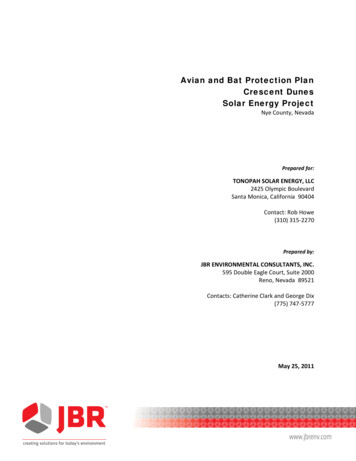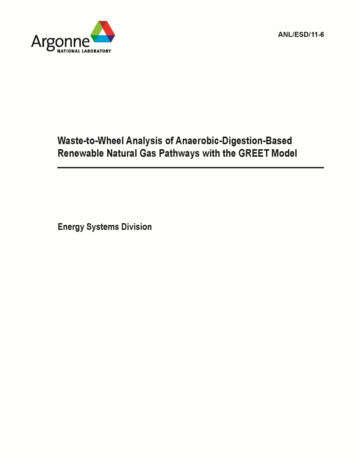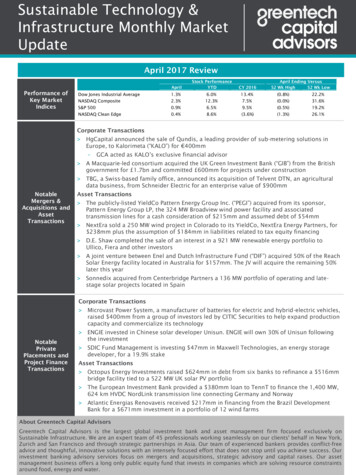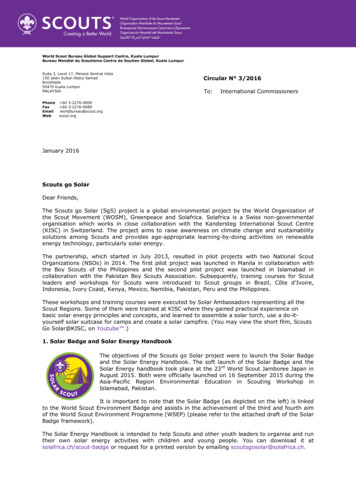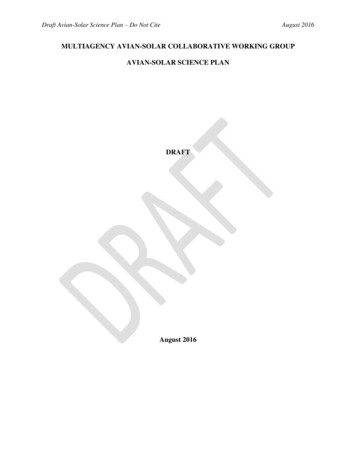
Transcription
Draft Avian-Solar Science Plan – Do Not CiteAugust 2016MULTIAGENCY AVIAN-SOLAR COLLABORATIVE WORKING GROUPAVIAN-SOLAR SCIENCE PLANDRAFTAugust 2016
Draft Avian-Solar Science Plan – Do Not CiteAugust 2016
Draft Avian-Solar Science Plan – Do Not CiteAugust 2016CONTENTSNOTATION . iiiEXECUTIVE SUMMARY .v1 INTRODUCTION.11.1 Background on Solar Energy Development in the United States .11.2 Regulatory Context .41.3 Multiagency Avian-Solar Collaborative Working Group.51.4 Timeline of CWG Activities .61.5 CWG Management Questions .61.6 Components of the Science Plan .71.7 Science Plan Review .102 CONCEPTUAL FRAMEWORK OF AVIAN-SOLAR INTERACTIONS .112.1 Avian Life Cycle Conservation .112.2 Conceptual Hypothesis Model of Avian-Solar Interactions.132.2.1 Solar Energy System Components and Impacting FactorsError! Bookmark not defined.2.2.2 Direct Effects on Birds .152.2.3 Indirect Effects on Birds .172.2.4 Landscape Context Considerations .172.3 Summary .183 SUMMARY OF EXISTING AVIAN-SOLAR INFORMATION AND RELATEDACTIVITIES.193.1 Overview of Existing Avian-Solar Information .193.1.1 Sources of Avian-Solar Information .193.1.2 Summary of Existing Avian-Solar Interactions .223.1.3 Existing Avian Monitoring Requirements, Mitigation Measures, and BestManagement Practices at Solar Facilities .233.1.4 Conclusion .243.2 Research that Addresses Avian Interactions with Solar Energy Facilities .243.2.1 Habitat Modeling To Inform Energy Development .243.2.2 Monitoring Methodology for Solar Facilities .253.2.3 Efficacy of Wildlife Monitoring Technologies .253.2.4 Solar Fatality Estimator and “Evidence of Absence” Software .253.2.5 Assessment of Energy Development Impacts on Sensitive Bird and BatSpecies and Populations .253.2.6 Assessing California's Mitigation Guidelines for Burrowing OwlsImpacted by Renewable Energy Development .253.2.7 Development of a Genoscape Framework for Assessing Population-LevelImpacts of Renewable Energy Development .253.3 Studies that Address Solar Flux-Related Impacts .263.4 Efforts Related to The Multi-Agency CWG .273.5 Potentially Applicable Wind Energy Experiences and Lessons Learned .293.5.1 Importance of Adequate Assessment .29i
Draft Avian-Solar Science Plan – Do Not CiteAugust 20163.5.2 Importance of Interdisciplinary Discussion.293.5.3 Importance of Developing Study Guidelines .293.5.4 Importance of Setting Objectives for Good Outcomes .294 IDENTIFYING INFORMATION AND DATA NEEDS .315 PRIORITIZING RESEARCH AND MONITORING NEEDS .356 IMPLEMENTATION OF THE AVIAN-SOLAR SCIENCE PLAN .396.1 CWG Member Agency Roles and Responsibilities .396.2 Potential Funding Sources and Requirements .416.3 Supporting Adaptive Management .416.4 Updating the Avian-Solar Science Plan .427 REFERENCES .43APPENDIX A: CWG MANAGEMENT QUESTIONS . A-1APPENDIX B: RELATIONSHIP BETWEEN CWG AND ASWG QUESTIONS .B-1FIGURES1-12-12-26-1Total Solar Energy Production (MW) by County among Major Solar EnergyProjects 1 MW (Source: SEIA 2016a).2Annual Life Cycle of the Tree Swallow (Modified from Small-Lorenz et al. 2013)Error! Bookmark notConceptual Hypothesis Model of Avian-Solar Interactions .14Implementation Process for the Avian-Solar Science Plan .40TABLES1-11-21-32-13-14-15-1Common Utility-Scale Solar Technologies .3Timeline of CWG Activities in 2016 .7Summary of Avian-Solar CWG Management Questions .9Known and Hypothesized Causes of Direct Effects of Solar Energy Developmenton Birds .16Summary of Current Avian Monitoring Activities at Utility-Scale Solar Facilitiesas of May 2016.20Summary of Available Information and Data Gaps Relevant to the CWGManagement Categories.33Summary of Initial CWG Research Priorities .37ii
Draft Avian-Solar Science Plan – Do Not CiteAugust 2016NOTATIONThe following is a list of acronyms, initialisms, and abbreviations used in this document.ArgonneASWGArgonne National LaboratoryAvian-Solar Working mpactBird and Bat Conservation StrategyBald and Golden Eagle Protection Act of 1940Bureau of Land Managementbest management practiceBats and Wind Energy Cooperative CCFRCSPCWGdegree(s) CelsiusCode of Federal Regulationsconcentrating solar powerCollaborative Working GroupDOEU.S. Department of EnergyEIAESAEnergy Information AdministrationEndangered Species Act of 1973FRFederal ah Solar Electric Generating StationkWkilowatt(s)LSALarge-scale Solar Associationm2MBTAMWsquare meter(s)Migratory Bird Treaty Act of 1918megawatt(s)NEPANGONRELNWCCNational Environmental Policy Act of 1969non-governmental organizationNational Renewable Energy LaboratoryNational Wind Coordinating Collaborativeiii
Draft Avian-Solar Science Plan – Do Not CiteAugust 2016PEISPVSEIAprogrammatic environmental impact statementphotovoltaicSolar Energy Industries AssociationUSCUSFWSUSGSUnited State CodeU.S. Fish and Wildlife ServiceU.S. Geological SurveyWESTWestern EcoSystems Technology, Inc.iv
Draft Avian-Solar Science Plan – Do Not CiteAugust 2016EXECUTIVE SUMMARYRecent federal incentives and state mandates to deploy renewable energy, along withrapid advances in the efficiency of solar energy technology, have led to a proliferation of utilityscale solar energy development across the United States. Despite its potential environmentalbenefits, utility-scale solar development can directly and indirectly impact birds and may alsopotentially impact bird populations. Avian interactions with utility-scale solar development, inparticular avian fatalities, are not well understood, and, if not properly addressed, could affectavian populations and present an impediment to meeting federal and state renewable energygoals. Uncertainty regarding probable avian impacts has the potential to cause delays in projectapprovals and/or increased costs associated with avian monitoring activities. Thus a betterunderstanding of the nature and magnitude of avian interactions with utility-scale solar facilitiesis important in order to support well-informed agency decisions regarding permitting anddevelopment of appropriate minimization, mitigation, and conservation requirements.Recognizing the need for interagency communication and collaboration on advancing theknowledge of avian-solar interactions, various federal and state agencies have established aMultiagency Avian-Solar Collaborative Working Group (CWG). The primary goal of the CWGis to develop better information that can be used to inform future agency actions to reduce theimpacts of solar energy development on birds. To achieve this goal, the CWG is preparing thisAvian-Solar Science Plan to accomplish the following objectives: Synthesize the current understanding of avian-solar interactions and relatedactivities; Identify and prioritize information needs to better understand interactions; and Provide an implementation framework that will guide future agencymanagement and research activities, complement the research effort of othergroups, and support the development of appropriate and cost-effectivemonitoring and mitigation measures.The Avian-Solar Science Plan presented here lays out a framework for future avian-solarresearch activities by clearly identifying a collective set of information needs and establishingresearch priorities. Information needs and research priorities are driven by the managementquestions facing the CWG member agencies (Table 1-3). This framework identifies andprioritizes information needs based on an understanding of how solar development may impactbirds (Section 2) and an understanding of existing avian-solar information (Section 3). Theavian-solar conceptual model (Figure 2-2) identifies many topical areas where more informationis needed in order to understand avian mortality risk at solar facilities. These include (but are notlimited to):v
Draft Avian-Solar Science Plan – Do Not CiteAugust 2016 Technology-specific factors that contribute to risk (e.g., collision, solar flux1effects); Project and site design considerations, including retention of habitat withinfacility boundaries; Impacts of ancillary facilities (e.g., fences, transmission lines); The role of facility attraction to birds and prey (e.g., “lake effect hypothesis”); Construction and operational practices that contribute to risk (e.g., seasonaltiming, implementation of best management practices [BMPs]); Exogenous factors that contribute to risk, including local and regional habitatconditions, time of day and year, functional guild, taxonomy, life cycle,residency, and transience; Indirect, direct, and cumulative impacts; Population-level consequences of avian-solar interactions; Potential benefits to avian populations from best management practices forsolar energy development and reduced carbon dioxide emissions; Methodologies for identifying cause of death; Effectiveness of existing monitoring protocols, data quality, andcomparability; and Effectiveness of mitigation measures (e.g., deterrents).An important objective of this Science Plan is to provide a framework for prioritizingthose research and monitoring activities that would provide the greatest advancements in termsof improving the understanding of avian-solar interactions and assisting in the development ofappropriate siting, permitting, monitoring, and mitigation decisions. Research is important tobetter understand the mechanisms by which birds or bird populations may be affected by solarenergy development, and such research will lead to the development of appropriate monitoringmethods. Monitoring that is scientifically supported will allow for the necessary data to becollected to better understand the impacts of solar developments on birds, and, through anadaptive management process, inform the selection of appropriate minimization and mitigation1 Some solar power technologies concentrate the sun’s energy by many times, resulting in potential exposure ofbirds to increased energy levels. Solar flux is a measure of the amount of solar energy passing through an area.The amount of solar flux from ambient sunlight is equivalent to about 1 kW per square meter (kW/m2).vi
Draft Avian-Solar Science Plan – Do Not CiteAugust 2016measures. The CWG developed several criteria, with input from stakeholders,2 to facilitate theprioritization of research needs. These criteria are as follows (in order of importance3):1. Sequence/Foundationality – Fundamental questions that need to be addressedprior to addressing others. This criterion prioritizes the more immediatequestions that need to be addressed prior to addressing other questions. TheCWG believes that addressing information needs in sequence and prioritizingactivities that are prerequisites to other information needs is of upmostimportance to understanding avian-solar interactions. One example of afoundational data need is better understanding of avian baseline movementacross the landscape to inform how solar facilities may interact with avianmigration routes.2. Management – This criterion prioritizes questions that are important foragency decision-making. There are several information needs of managementimportance, such as the development of methods to better understand guildand population-level impacts from solar development. There is a sequence(criteria #1) to addressing some management questions. For example,understanding whether and to what degree solar facilities may attract birds isneeded to understand the nature and magnitude of avian impacts in order tomake management decisions.3. Basic Process – This criterion prioritizes consideration of basic ecologicalprocesses that influence avian behavior and natural history. Processes such ashabitat associations and predator-prey relationships are addressed under thiscriterion. These questions also address the net effects on birds. Although thiscriterion was not ranked as highly as sequence and management overall, theremay be a sequence/foundational need to understand some basic processes.4. Timeliness – This criterion prioritizes questions that can be addressed in under3 years. While it is preferred to have the results of research activitiesdisseminated as soon as possible, the CWG recognizes that longer-termresearch designs may be needed to address information gaps in a scientificallysound manner. Additional effort may be required as bird activity is subject tointer-annual variation.5. Overlap – This criterion prioritizes questions that are shared by more than oneagency.6. Budget – This criterion prioritizes considerations for cost. Under this criterion,questions that can be addressed with low-cost activities are favored.2 In the stakeholder workshop held in May 2016, stakeholders were asked to comment on management questionprioritization criteria.3 The CWG ranked these criteria in order of most important to least important (see Section 5).vii
Draft Avian-Solar Science Plan – Do Not CiteAugust 2016On the basis of the ranked criteria presented above and consideration of the informationgaps discussed in Section 4, research priorities have been identified to address CWGmanagement questions. These CWG priorities (discussed in Section 5) fall within three broadresearch themes:1. Baseline understanding of regional avian activity, abundance, and potentialfor solar interactions;2. Mechanisms by which birds interact with solar facilities, such as the role ofavian attraction in causing avian fatalities at solar facilities (e.g., “lakeeffect”); and3. Methods to better understand the magnitude of population- or guild-specificimpacts.Table ES-1 summarizes the selection of these research priorities and presents arecommended schedule for the development of research to address them.Section 6 presents information on how this Science Plan may be implemented. Thissection discusses agency roles and responsibilities, potential funding sources and requirementsfor future avian-solar research activities, use of research results to support adaptive managementapproaches, and future updates to the Science Plan. It is anticipated that future research will tierfrom the Science Plan and that CWG member agencies will use the Science Plan to supportinternal budgetary actions, the premise being that the plan provides justification for specificresearch initiatives and funding allocations.viii
Draft Avian-Solar Science Plan – Do Not CiteAugust 2016TABLE ES-1 Summary of Near-term CWG Research PrioritiesCWG ManagementQuestions AddressedaRecommendedScheduleThe CWG identified this as a high-priority information needbecause it represents a foundational need to address otherquestions and inform agency decision-making. This prioritydirectly addresses several CWG management questions; it wasalso identified as an information need in Table 4-1. Suchactivities will aid in the identification of avian migratoryflyways and inform decisions on project site selection and theselection of avoidance, minimization, and mitigation measures.1. Baseline Informationand LandscapeConsiderationsInitial researchactivities should beginsoon; some results maybe available within1 year.The CWG identified this as a high-priority information needbecause it represents a foundational need to understand othermanagement questions and inform agency decision-making. Itwas also identified as an information need in Table 4-1. Thispriority will be used to better understand the role and scale ofavian attraction to solar facilities in causing avian mortality. Itcan also be used to understand the need for and the developmentof appropriate minimization and mitigation measures andBMPs.3. Sources of Mortalityand Injury;Initial researchactivities to understandavian attraction to solarfacilities may becompleted within2–3 years. Results willbe important inunderstanding avianmortality risk.Research PriorityDescription1. Baseline avianactivity,abundance, andpotential forinteraction2. Mechanisms bywhich birdsinteract withsolar facilities4. Avian Behavior(Attraction/Avoidance);6. Taxonomic andGuild-Specific Impacts7. Minimization,Mitigation, andAdaptive Management3. Methods tounderstand themagnitude ofavian impactsaThe CWG identified this as a high-priority information need2. Methods To Evaluate Initial research tobecause of its management importance in agency decisionAvian Risk and Impacts develop methods tomaking. It was also identified as an information need inunderstand avianTable 4-1. Prioritized research will focus on developing andimpacts may betesting methodology to better understand impacts, as well ascompleted withinsynthesize existing data to understand impact magnitude. The1–2 years.development and testing of methodology to evaluate impactscould occur concurrent with other, more foundational, activities.See CWG Management Questions in Table 1-3. Questions are numbered and ordered as they appear in Table 1-3.ix
Draft Avian-Solar Science Plan – Do Not CiteAugust 2016x
Draft Avian-Solar Science Plan – Do Not CiteAugust 20161 INTRODUCTION1.1 BACKGROUND ON SOLAR ENERGY DEVELOPMENT IN THEUNITED STATESStretching back over a decade, a number of federal mandates and policies have beenissued promoting expedited development of domestic renewable energy resources. Theimportance of this development was underscored in 2013 with issuance of The President’sClimate Action Plan (Executive Office of the President 2013), which set a priority on reducingcarbon emissions to limit climate change and related public health impacts, in part, throughaccelerated deployment of renewable energy technologies, including utility-scale solar power.This priority is consistent with and supported by state-level Renewable Portfolio Standards thatestablish timelines for achieving specific levels of electricity generation from renewable sourceswithin a given state. Accordingly, increased development of utility-scale solar energy isconsidered critical in the fight against climate change, although this development—like all formsof energy development—must be done in an environmentally sound manner.Renewable energy development has been increasing as an alternative to fossil-fuel-basedtechnologies, in large part to reduce toxic air emissions and carbon-dioxide-induced effects onclimate (Shafiee and Topal 2009; Allison et al. 2014). According to the U.S. Energy InformationAssociation (EIA 2014), electric generation from renewables in the United States has increasedby more than 50% since 2004, and renewable energy sources currently provide approximately14% of the nation’s electricity. Solar-energy-based technologies represent a rapidly developingrenewable energy sector that has seen exponential growth in recent years (Lewis 2007; Bolingerand Weaver 2013).Utility-scale solar energy projects generate electricity for delivery via the electrictransmission grid and sale in the utility market. Solar projects 1 MW are often considered to beutility-scale (Ong et al. 2013).4 This differs from distributed solar energy systems which aredesigned at smaller scales ( 1 MW). According to the Solar Energy Industries Association(SEIA 2016a), there currently are more than 1,200 utility-scale solar energy projects ( 1 MW)that are under construction or in operation in the United States, representing nearly 18 GW ofelectric capacity. Most of the utility-scale solar energy development in the United States to datehas occurred in the southwestern states, where the greatest solar resource potential is located(Figure 1-1).There are two basic types of solar energy technology (Table 1-1): photovoltaic (PV) andconcentrating solar power (CSP). Photovoltaic systems use cells to convert sunlight to electriccurrent, whereas CSP systems use reflective surfaces to concentrate sunlight to heat a receiver.The heat is converted to electricity using a thermoelectric power cycle. CSP systems typically4 The Bureau of Land Management (BLM) considers utility-scale solar projects to be 20 MW (BLM andDOE 2012).1
Draft Avian-Solar Science Plan – Do Not Cite2August 2016FIGURE 1-1 Total Solar Energy Production (MW) by County among Major Solar Energy Projects 1 MW(Source: SEIA 2016a)
Draft Avian-Solar Science Plan – Do Not CiteAugust 2016TABLE 1-1 Common Utility-Scale Solar TechnologiesTechnologyPhotovoltaic(PV)Key Features Simple design May be fixed-tilt (nomovement of the panelswith the sun) or tracking toallow panels to follow thesun Thin-film or silicon cells No cooling waterrequirementConcentratingSolar Power(CSP) –ParabolicTrough Linear receivers withsingle-axis tracking Can include thermal energystorage Can be wet- or dry-cooled,may include evaporationponds Most common CSPtechnologyCSP – PowerTower Two-axis tracking heliostatssurround a central towermounted receiver Can include thermal energystorage More cost effective thanparabolic troughs Can be wet or dry cooled3
Draft Avian-Solar Science Plan – Do Not CiteAugust 2016include power tower systems with heliostats (angled mirrors) and parabolic trough systems(parabolic mirrors). In the United States, approximately 75% of the electricity produced byutility-scale solar energy projects is generated using PV technologies (SEIA 2016b).Despite its benefits, utility-scale solar development can impact ecological systems andother environmental resources, including species and their habitats (Lovich and Ennen 2011;Hernandez et al. 2014). The most obvious impact of a solar power plant is the occupied land area.In general, solar plants occupy between 8 and 10 acres per megawatt (MW) of electricity andbetween 3 and 4 acres per annual gigawatt-hour (GWh) of generation (Ong et al. 2013). Suchlarge human footprints, which may exceed 1,000 acres for a single solar project, may result inhabitat loss and fragmentation for many wildlife species. In addition, recent studies havedemonstrated that utility-scale solar projects represent a source of fatality for wildlife such asbirds (e.g., Kagan et al. 2014). However, there are relatively few systematic and empiricallybased studies that address avian mortality issues at solar facilities (See Section 3.1).1.2 REGULATORY CONTEXTSeveral federal and state regulations provide the legal framework for addressing avianfatality issues at solar energy facilities. The Migratory Bird Treaty Act (MBTA) (16 USC 703) isthe cornerstone of migratory bird conservation by protecting most native species of birds in theUnited States. The MBTA makes it unlawful to “take”5 migratory birds (or their nests or eggs).The U.S. Fish and Wildlife Service (USFWS) is currently considering a proposed rule toauthorize the incidental take of migratory birds, which would evaluate several approaches toregulating incidental take, and establish appropriate standards to ensure that incidental take isappropriately mitigated (80 FR 30032). To minimize impacts on migratory birds, the USFWSrecommends development of a project-specific Bird and Bat Conservation Strategy (BBCS). TheUSFWS is also currently developing programmatic guidance for the development of BBCSs atsolar energy facilities (USFWS 2016a).In addition to the MBTA, the Endangered Species Act (ESA) provides the regulatoryframework for the protection and conservation of threatened or endangered bird species. Whilethreatened and endangered species may be discussed in project-specific BBCSs, if solar projectshave the potential to impact ESA-listed species, impacts on these species are required to beaddressed through ESA consultation with the USFWS or National Marine Fisheries Service.Bald and golden eagles are protected under the Bald and Golden Eagle Protection Act(BGEPA) (16 USC 668-668d). The BGEPA authorizes the USFWS to permit the take of eaglesunder certain circumstances, so long as it is compatible with the preservation of eagles(16 USC 668a). The USFWS recently proposed changes to the BGEPA regulations governingpermits for incidental take of bald and golden eagles (USFWS 2016b).Solar projects sited and designed with a federal nexus (e.g., constructed on or having oneor more components constructed on federal land) are required to use the National Environmental5 “Take” is defined as “pursue, hunt, shoot, wound, kill, trap, capture, or collect” (50 CFR 10.12).4
Draft Avian-Solar Science Plan – Do Not CiteAugust 2016Policy Act (NEPA) process to evaluate environmental impacts associated with the proposedproject, including impacts on migratory birds and those listed under the ESA. The analysis ofimpacts presented in NEPA assessments may be used to inform necessary consultation with theUSFWS under Section 7 of the ESA and in the preparation of project-specific BBCSs.In addition to federal regulations, there are also state regulations governing the impacts tomigratory bird species. For example, California Game Code Section 3513 makes it unlawful totake or possess any migratory nongame bird species designated in the MBTA or any part of suchmigratory nongame bird except as provided by rules and regulations adopted by the Secretary ofthe Interior under provisions of the MBTA.1.3 MULTIAGENCY AVIAN-SOLARCOLLABORATIVE WORKING GROUPAvian interactions with utility-scale solar development, in particular avian fatalities, arenot well understood and, if not properly addressed, could affect avian populations and present animpediment to meeting federal and state renewable energy goals. Utility-scale solar projectdevelopment costs are driven in part by the costs of project siting, design, permitting, and timelyaccess to suitable tracts of land. Uncertainty regarding2016 CWG Member Agenciespotential avian impacts has the potential to cause delaysin project approvals and/or increased costs associated Arizona Game & Fish Departmentwith avian monitoring activities. Understanding the Bureau of Indian Affairs Bureau of Land Managementnature and magnitude of avian interactions with utility California Department of Fish &scale solar facilities is an important first step toward theWildlifedevelopment of better project siting decisions and the California Energy Commissionimplementation of science-based and cost-effective California Public Utilities Commissionmonitoring, avoidance, minimization, and mitigation National Park Serviceprotocols. To this end, in January 2016, various federal Nevada Departmen
Draft Avian-Solar Science Plan - Do Not Cite August 2016 iii NOTATION The following is a list of acronyms, initialisms, and abbreviations used in this document. Argonne Argonne National Laboratory ASWG Avian-Solar Working Group BACI before-after-control-impact BBCS Bird and Bat Conservation Strategy . Construction and operational .
